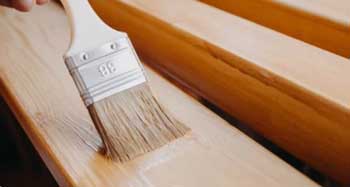If you are looking for the best clear coat to use over your acrylic paint job, then you have come to the right place. In this article, we will be discussing the best clear coat over acrylic paint, as well as some tips and tricks to make sure that your paint job looks its best.
Do You Need To Prime Wood Before Painting With Acrylics?
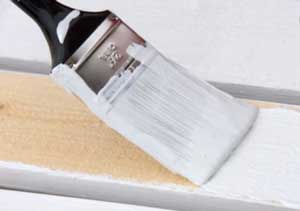
The short answer is no. You don’t need to prime wood before painting with acrylics. But it can make a big difference in your final product, so we’ll get into why that is later.
Acrylics are water-based paints, which means they aren’t as strong as oil or shellac-based paints. When you apply them directly onto a surface like wood, they can easily soak into the grain and cause bleeding and streaking when applied over other colors.
This is where primer comes in: primers seal the surface of the wood so that paint doesn’t soak into it, so you don’t have to worry about bleed through or other issues caused by paint soaking into the grain of your wood piece.
A good primer will also help protect your piece from getting damaged from moisture and staining from other materials like dirt or dust getting trapped underneath your paint job.
Does Acrylic Paint On Wood Need To Be Sealed?
After you have finished painting wood using acrylics, you will need to seal the paint. Sealer prevents paint from flaking and peeling by sealing the surface.
If the surface is not properly sealed, wood has a tendency to hold impurities that cause it to take on an amber yellow or brown hue unless the surface is properly coated. This prevents the wood from discoloring.
Can You Put A Clear Coat Over Painted Wood?
Yes, they are utilized very frequently, and even to a greater degree so as to improve the natural glow and hues of the wood essences.
A much-needed facelift can be given to virtually any wooden piece, such as furniture, cabinets, or room trim, with the application of a new coat of paint. Continue with the process by applying a layer of clear polyurethane over the painted surface.
What Is A Clear Coat On Wood?
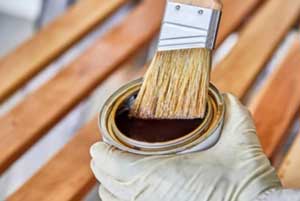
The application of a clear coat to wood results in the creation of a protective layer that shields the wood from damage caused by stains, water, and natural wear and tear. If a clear varnish that is water-based is applied to raw wood that is light in color, it is possible to stop the natural yellowing process of the wood, which helps to maintain the integrity of the cooler tones.
The clear coat can also be used as a finishing product for furniture or other pieces of home decor that are made from wood.
What Is The Best Clear Coat For A Painted Wood Table?
1. Varathane Water-Based Ultimate Polyurethane

Varathane water-based polyurethane in the satin finish is widely considered to be the best clear coat for painted wood tables. After putting seven different products through rigorous testing, the Water-Based Polyurethane offered by Varathane emerged as the undisputed victor! This clear coat works wonderfully for interior products such as table, furniture, cabinets, trim, and any other pieces of wood you might have lying around.
Why Should I Clear Coat My Wood Furniture?
After the piece of furniture you painted or stained has completely dried, you will need to apply a clear coat, which is also often known as a poly finish or topcoat. This coat is essentially a transparent protective coating that you brush on. This coating of clear acrylic acts as a protection for the item, protecting it from scuffs, water rings left by drinking glasses, and general grime.
It is important to use an orbital sander when applying the topcoat because this will give the wood surface a smoother finish.
2. Liquitex Professional Gloss Varnish

Specification:
- Nullify
- Imported
- Permanent; non-removable; shiny
- Non-hazardous and not very heavy Dries non-tacky, firm, and flexible; dries without yellowing; does not yellow
- Contains a medium bottle of 8 ounces or 237 milliliters
- Paints and mediums made by Liquitex can be combined with one another.
- Complies with the standards set by the ASTM D4236 for use in educational settings.
When it comes to acrylic mediums, Liquitex has the widest selection available to encourage creative expression throughout the entire painting process. The painting surface is shielded from the elements by varnish mediums, and the pigments are shielded from ultraviolet light by the varnish mediums.
The Liquitex Archival Permanent Varnish Finishing Medium has a low odor, is permanent and durable, is made using a technology based on water, is translucent when wet and clear when dry, and is a medium with these characteristics.
Maintains its original color (does not yellow or fog up) even when exposed to high humidity, heat, or UV radiation. It is compatible with Spray Paint, Heavy Body Paint, and Soft Body Paint.
Dries to a surface that is not tacky, firm, flexible, and resistant to the retention of dirt and dust. When dried, the material is archival-grade, hard, colorless, and impervious to water.
Acrylic color is shielded from the damaging effects of the environment. Suitable for usage both indoors and outdoors.
Application
Use as a final varnish over acrylic paint that has been allowed to dry. Both the surface to be varnished and the surrounding environment need to be spotless, dust-free, and dry.
Before varnishing, acrylic paintings need to have a complete drying and curing time of between 48 and 72 hours. Brushing it on is one option, while spraying it on is another.
Spraying an application results in a coating that is often thinner, smoother, and more even. The application method of rolling or sponging is not suggested. Caution is advised when working with acrylic paints and media in cold weather since they become more fragile. Do not apply below 60 degrees Fahrenheit.
How Do You Use Acrylic Polymer Varnish?
Acrylic polymer varnish is a water-based finish that you can use to seal, protect and beautify your work.
Mix four parts varnish to one part water for application with a brush; two parts varnish to one part water for application with a spray gun.
As needed To prevent Satin and Matte solids from settling, varnishes are made thicker than is strictly necessary.
How Do You Use Liquitex Acrylic Varnish?
- Before applying varnish, you need to make sure the paint surface is completely dry (this can take anywhere from 72 hours to two weeks, depending on the thickness), and that the area is well aired and clear of dust.
- Pick the format and sheen that best suits your needs. Before applying for a job, you should always give yourself a test.
- Place the item to be varnished horizontally on a table; varnishing should never be done vertically.
- Before using varnish, give it a light stir (to prevent bubbles) or give the spray a good shake. Do not use water to thin the mixture.
- When applying, be sure to use a brush, pad, airbrush, or spray that is clean, wide, and has soft hair. When applying, make sure to use long, even strokes or mists to cover the surface from top to bottom as you move from one side to the other.
- Applying more than one or two thin coats of the Liquitex Matte or Satin Varnish is not recommended because thick applications may result in cloudiness once they have dried. If you want to apply more than two coats of varnish, start by building up the thickness with a coat of gloss varnish, then add a coat of matte or satin varnish as the last coat.
- Between coats, there should be at least three hours of drying time.
- It is preferable to apply several thin coats rather than one thick coat, which will take longer to dry, may become murky when it dries, may drip or sag while it is being applied, and has a larger risk of revealing brush strokes once it has dried.
- It is important to avoid excessive over-brushing since this might cause the finish to become hazy. While you are working, look for bubbles in the varnish coat from all different angles. Straight away, they are equalized.
- You are not permitted to return to a location once you have left it. If you do that, you run the risk of dragging resin that is only half dry into wet areas, which will cause the resin to dry hazy over dark hues. Allow any areas that were missed to dry completely before applying a second coat of varnish.
What Does Polymer Varnish Do?
Polymer Varnish is intended to be used as a topcoat for acrylic paintings. It provides a protective surface that may be removed without damaging the layer of relatively soft acrylic paint.
Polymer Varnish may be applied over acrylic paintings that are already dry and hardened, or it may be applied to wet acrylics in order to lock in color and create an even surface with which paint can be applied.
Is Liquitex Varnish Waterproof?
Liquitex Varnish is a professional-grade acrylic varnish that dries to a durable, flexible film of color.
The varnish is water resistant and exceptionally stable, so you can feel confident knowing that your work will not fade or change over time.
3. Sargent Art Acrylic Gloss and Varnish

Specification:
- AP-approved, as well as non-toxic and risk-free
- Dries to a finish that is permanent, waterproof, and protective.
- Acrylic paint can be mixed with it, or it can be used as a transparent coat.
- Free of acidity
- Made in USA
After drying, the finish is permanent, weatherproof, and protective. You can use it as a clear coat or mix it with acrylic paint to make the gloss level higher. Water-reducible. Before it dries, it can be cleaned with soap and water. AP approved, non-toxic, and does not contain any acid.
Sargent Art’s acrylic gloss and varnish are perfect to use on a variety of art, craft and home projects. It dries quickly, seals your projects and protects them from water, dust and dirt.
The non-toxic formula is safe to use on any surface without worrying about harmful chemicals or fumes. This 16-ounce bottle can be used with both acrylic paints and mixed media techniques, or as a protective clear coat over finished projects.
Mix it with paint for an enhanced look, or use it by itself for a clear finish that provides waterproof protection for paintings.
4. Krylon Clear Polyurethane Gloss Finish
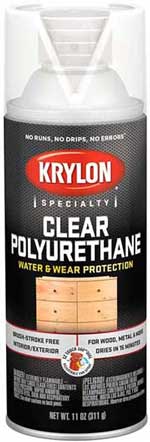
Specification:
- This product adds a lot of value to the mix.
- Perfect for insulating mechanical, electrical, and electronic components
- One application does the job of both weatherproofing and waterproofing.
- Provides a barrier against moisture and stains on surfaces
- Dries in minutes
Krylon Clear Polyurethane Gloss Finish is ideal for sealing electrical and electronic parts. This water-based finish keeps out moisture, which can cause rusting and corrosion of parts.
The finish is also great at resisting UV rays, which helps avoid fading in furniture, car interior trim and other areas exposed to intense sunlight. Can be applied directly over rubber, plastic, vinyl and more. Will not yellow.
Is Krylon Clear Coat Polyurethane?
Krylon clear coat is not polyurethane. It is a synthetic lacquer that dries by evaporation, not polymerization, so it cannot be considered polyurethane.
Dries in minutes. Provides surfaces with protection against water and stains.
Does Krylon Clear Polyurethane Yellow?
Krylon is a great brand, but it’s not perfect. While their clear polyurethane may yellow over time, they also offer a number of other products that can help you achieve the look you want without having to worry about yellowing.
What Is Polyurethane Spray Paint Used For?
Polyurethane spray paint is a type of coating used to seal and protect surfaces. It’s made from a liquid resin and an isocyanate, which when combined, harden into a solid plastic.
Polyurethane spray paint can be used on a wide variety of materials, including wood, metal, glass and plastic. It provides protection from moisture and other elements that could cause deterioration or damage.
It has many applications, including:
- Sealing surfaces before painting them or protecting them from the elements (such as rain) after painting them
- Protecting surfaces from wear-and-tear or damage caused by friction (such as on door knobs)
Is Clear Spray Paint The Same As Polyurethane?
No. Clear spray paint is not the same as polyurethane.
It can be clear or tinted to any color of your choosing. It’s also used in home improvement projects such as countertops and cabinets.
5. Golden Artist Colors Isolation Coat

Golden Artist Colors Supplies Isolation Coat is an essential component in any artist’s paint palette. This acrylic blend has been developed to provide a protective, yet flexible surface coat on acrylic paintings.
It can be applied to unify and protect the surface while allowing the painting to breathe. Isolation coats can be applied prior to varnishing to ensure an even application of varnish and protect against possible damage if or when varnish is removed.
How Do You Use Golden Acrylic Polymer Varnish?
The first step is to clean your piece with soap and water. Dry the surface of the painting with a clean cloth, then apply Golden acrylic polymer varnish using a brush or sponge applicator. You don’t need to apply much; just one thin coat will do!
Let dry for about 20 minutes, then apply another coat if necessary.
To use Golden acrylic polymer varnish, you should:
- Shake the bottle well before using it.
- Apply the varnish in thin coats, as this will ensure that you get a smooth finish and that your varnish dries quickly.
6. Golden Artist Colors Isolation Coat
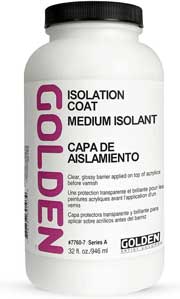
Specification:
- It acts as a barrier between varnishes and acrylics.
- Provides protection for the artwork in the event that the varnish is removed
- Produced in the United States
This product should be used over Golden Heavy Body Acrylics, Golden Fluid Acrylics or Golden High Flow Acrylics only, and not over other brands of acrylic paints. Isolation Coat is fast drying and durable when dry, making it ideal for outdoor projects and indoor murals.
How To Paint On Wood With Acrylics?

Painting on wood with acrylic paints is a great way to bring out the natural character of your wood. This tutorial will show you how to paint on wood with acrylics.
Step 1: Start by cleaning and sanding your wooden board. Use 220-grit sandpaper to remove any existing varnish or paint from the surface of your board before painting. You may also want to apply a sealer or primer at this point if you plan to use the same type of paint later, but it is not necessary if you are only going to paint once.
Step 2: Apply an even layer of primer over the entire surface of your board. Allow it to dry completely before proceeding.
Step 3: Use a wide brush to apply a base coat in any color you choose over the entire surface of your board (it doesn’t matter what color). Allow it to dry completely before proceeding.
Step 4: Use a smaller brush (or even an artist’s palette knife), and carefully add additional layers of color until you reach the desired depth of coloration in each area. If you would like a distressed look for an old-looking finish, be sure that some areas stay lighter than others when applying these additional layers so that they appear unevenly faded and worn down over.
How To Protect Acrylic Painting On Paper
To protect your acrylic painting on paper, you can use a spray-on sealer. This will add a layer of protection and UV protection to your work.
You can also protect your work by framing it behind glass. This will protect it from fading and from the effects of moisture in the air.
How To Protect Acrylic Paintings On Canvas
First, keep it out of direct sunlight. This means storing it in a closet away from windows and other sources of bright light. The sun’s UV rays can damage the paint and cause it to fade more quickly than it would if it were protected from the sun’s rays.
Next, avoid putting anything acidic on the painting (like coffee cups) or allowing any liquids to come into contact with it. You should also make sure that any cleaning products used do not contain ammonia or alcohol as these will also damage your painting over time.
Finally, make sure that when transporting your canvas art you handle it gently so as not to scratch off any of the paintwork or leave fingerprints behind which may lead to staining later on down the road!
How To Protect Canvas Painting
Protecting your canvas painting is important to keep it looking as good as possible for as long as possible. Here are some tips for protecting your canvas painting:
1. Keep it out of direct sunlight and away from heat sources like radiators or vents
2. Avoid hanging it above a fireplace or on a wall near an open window where smoke from cooking can settle on the surface
3. Use a simple glass frame with UV protection to protect from dust, dirt and grime
4. If you have pets or children, consider using a varnish that is pet-friendly and childproof
How To Protect Canvas Painting From Dust
There are many ways to protect canvas paintings from dust.
Keep Canvas Paintings In A Dark Room
The first way is to keep your canvas paintings in a dark room. The dark room will prevent the paintings from being exposed to light, which can cause the paintings to fade over time. In order to keep them in the dark, it is best to place them on a wall that does not get much light or hang them in front of a window.
Using Glass Frames
Another way you can protect your paintings from dust is by using glass frames or cases. These frames and cases will protect your painting from dust, as well as keep them from getting damaged when they fall off of walls or tables.
Storing Canvas
Another way you can protect your paintings from dust is by storing them in drawers or cabinets that have been lined with felt paper so that they do not come into contact with any abrasive surfaces which could scratch their surfaces and cause damage over time!
Best Varnish For Acrylic Painting On Canvas
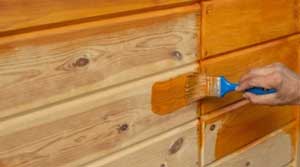
Varnishes are more than just a protective coating. They can also be used to enhance the appearance of your paintings, and turn them from drab to fab. Here’s how to pick the best varnish for acrylic painting on canvas.
1. Oil-Based Varnishes
Oil-based varnishes are a great choice for protecting your paintings from dirt, dust and grime, but they can be difficult to use because they are thick and tend to yellow over time.
2. Water-Based Varnishes
A water-based varnish is a good option if you want a glossy finish on your piece; however, it can cause warping if applied too heavily or too often.
3. Acrylic Finishes
Acrylic paints dry quickly and don’t need much additional preparation before being applied to the surface of your painting—perfect if you’re in a hurry! But they don’t have much longevity so make sure you apply them sparingly so as not to block up any brush strokes underneath
How To Protect Acrylic Painting On Wood

Acrylic paintings are beautiful, colorful works of art that can be hung in any room of your home. However, if you want to protect your acrylic painting from fading or cracking over time, it’s important to know how to care for it. Here are some tips for protecting your acrylic painting on wood:
Avoid Direct Sunlight
Direct sunlight can fade an acrylic painting over time, so keep it out of direct sunlight as much as possible.
Keep It In A Cool Place
Acrylic paintings should be stored in a cool place like a basement or attic where they won’t get too hot or cold.
Store It Properly
Your acrylic painting should be stored flat so that its layers don’t crack or peel apart over time. Put down a piece of cardboard or foam board before storing the painting so it doesn’t get bent out of shape while being moved around on its own accord; this will also protect it from dust particles that might settle between each layer of paint and make them stick together instead of staying separate from one another during storage periods (which could cause them to crack when applied again later).
Isolation Coat For Acrylic Painting
The isolation coat is a very important part of the acrylic painting process. It keeps the paint from the previous layer from mixing with the current layer and allows for easier work in subsequent layers.
Acrylics are water-soluble, so they can be easily wiped away when applied to a surface that has been prepared with an isolation coat.
The best isolation coat is made from white gesso, which is available at any art store. The gesso should be mixed with water until it reaches a consistency that allows you to brush it onto your surface smoothly without leaving streaks or drips behind.
What Is The Difference Between A Protective Finish And A Varnish?
The main difference between a protective finish and varnish is the amount of gloss they have. Varnishes are used to create a high-gloss finish, while protective finishes are used to create a matte or satin finish.
Protective Finish
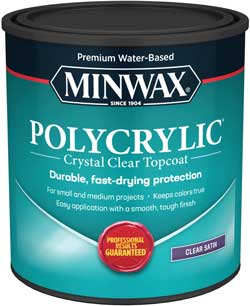
Protective coatings safeguard your furniture against elements such as water, grime, and ultraviolet rays that can cause wear and tear over time. They not only stop the wood from being discolored but also stop it from fading.
Varnish

Varnishes are applied to surfaces more for their cosmetic value than for their protective value. They have a higher shine than other finishes since they are manufactured with more pigments than the other alternatives, which means that they are made.
What Type of Varnish Should I Use To Seal Acrylics On Wood?
There are several different types of varnishes you can use to seal acrylics on wood.
The first type is the most common and comes in a variety of forms: spray, brush-on, or roll-on. You should choose a varnish that’s designed specifically for sealing acrylics on wood.
If you’re using an oil-based varnish, make sure it’s labeled as such. Otherwise, your acrylic paint will slowly dissolve over time and may even crack or peel off the surface of your board entirely if you use an oil-based product on top of it.
You can also use shellac as a sealant for acrylics on wood—you’ll just need to apply several coats over time to get enough protection, which can be expensive if you’re only using small amounts at a time.
What To Put On Acrylic Painting To Protect Them?
You can protect your acrylic paintings with a few simple steps.
First, clean the painting with a wet paper towel or cloth. This will remove any dust or dirt particles and allow you to see the surface more clearly.
Next, apply a thin layer of varnish to the painting. You can use a brush or spray bottle to apply this layer evenly across the surface of your painting. This will protect against UV rays and help prevent fading over time.
Finally, hang your painting in a spot where it gets plenty of light, but not direct sunlight (if possible). This will keep it from fading over time as well as make it last longer overall!
Can You Put Polyurethane Over Acrylic Paint?
Yes, you can put polyurethane over acrylic paint.
This is a typical procedure for finishing wood furniture or other items that are painted with acrylic paints. As long as the surface is dry and clean, you should be able to add polyurethane without any issues.
However, it’s important to remember that this is just one option among many for finishing acrylic-painted objects. You may want to experiment with other finishes if you’re looking for something different or if this doesn’t work out for some reason.
Can You Put Lacquer Over Acrylic Paint?
The answer is yes. You can put lacquer over acrylic paint, but it’s not recommended.
Lacquer is a clear, hard finish that dries quickly and works well on wood, metal, and other materials. It’s most often used as an alternative to varnish because it has fewer volatile organic compounds (VOCs), which are chemicals that can cause health problems when they’re inhaled or absorbed through the skin. Lacquer also provides more protection against moisture than varnish does.
Can You Use A Clear Coat Over Acrylic Paint?
The short answer is yes, you can use a clear coat over acrylic paint.
However, we recommend that you do not use a clear coat over acrylic paint if the paint has been on the surface for more than a month. The reason for this is that the acrylic paint will have dried and will be much harder to sand down than it was when it was first applied. This means that if you try to apply a clear coat over dry acrylic paint, it may not adhere well to the surface or may even peel off completely.
What Is The Best Finish To Protect Acrylic Paintings?
In order to protect your acrylic painting from damage and fading, you’ll want to apply a varnish or protective finish. There are several types of varnishes available, each with its own characteristics and uses.
One type of varnish is called gloss varnish. This type of varnish creates a highly reflective surface which can enhance the appearance of an acrylic painting. It also adds protection from UV rays which could otherwise cause fading over time.
Another type of varnish is matte varnish which provides a satin finish that minimizes reflections but still offers some protection against UV rays like gloss does (although probably not as much). Matte
Can You Use Different Types Of Clear Coats On Different Subjects?
The short answer is yes, you can use different types of clear coats on different subjects. However, it’s important to understand the differences between the different types of clear coats and how they are applied.
The most common type of clear coat used in the paint industry is called “aqueous” (pronounced uh-KEY-us) clear coat.
A second type of clear coat is called “cure-in-place” (CIP) or “hot melt.” CIP/hot melt clear coats are extremely durable but also take longer to dry than aqueous ones do because they’re designed to be applied at higher temperatures than aqueous ones—around 300 degrees Fahrenheit instead of 200 degrees Fahrenheit for aqueous ones.
What Should I Look For When Buying A Top-Coat For Acrylic Painting?

A top-coat is a clear, protective finish that can be applied to acrylic paintings to protect them from damage and fading. There are a few things to consider when choosing a top-coat for an acrylic painting:
1. What Level Of Protection Do You Need?
Some top-coats are more protective than others. If you are planning on displaying your painting in a high-traffic area or if it will be exposed to sunlight, you will need a top-coat that offers a high level of protection.
2. How Easy Is The Top-Coat To Apply?
Some top-coats are easier to apply than others. If you are new to using top-coats, you may want to choose one that is easy to apply and that comes with clear instructions.
3. What Is The Drying Time?
Top-coats can take anywhere from a few minutes to a few hours to dry. If you are in a hurry, you will need to choose a top-coat with a shorter drying time.
4. How Durable Is The Top-coat?
Some top-coats are more durable than others. If you need a top-coat that will last for years, you will need to choose a high-quality option.
5. What Is The Cost?
Top-coats can range in price from a few dollars to hundreds of dollars. You will need to decide how much you are willing to spend on a top-coat before you start shopping.
Frequently Asked Questions About Clear Coat Over Acrylic Paint
What Is Polymer Varnish Used For?
Polymer varnish is a type of clear coating that is typically used to protect surfaces from wear and tear, UV light, and other types of damage. It is often used on wood surfaces, as well as metal, plastic, and glass.
What Clear Coat Can Be Used Over Acrylic Paint?
Many clear coats can be used over acrylic paint, as long as the paint is fully cured. Some popular choices include polyurethane, epoxy, and urethane. You will need to experiment to find the clear coat that works best for your project.
Can You Clear Coat Over Acrylic Paint?
Yes, you can clear coat over acrylic paint. However, you should be aware that acrylic paint is not as durable as other types of paint, so the clear coat may not last as long.
Is There A Top Coat For Acrylic Paint?
Yes, there are top coats for acrylic paint. You can use a clear acrylic varnish or a clear urethane varnish. Apply the varnish with a soft brush or a spray can.
Should I Clear Coat My Acrylic Painting?
There is no right or wrong answer to this question, it is purely up to the artist’s preference. Some artists like to clear coat their paintings to protect them from damage, while others prefer to leave them unprotected so that they can continue to work on them if they choose.
Conclusion
There are many benefits to using a best clear coat over acrylic paint. Clear coats provide a protective layer that helps to prevent the paint from chipping, fading or becoming damaged. They can also enhance the appearance of the paint, giving it a glossy finish. Clear coats can be applied over both latex and oil-based paint, and they can be applied using a variety of methods, including spraying, brushing or rolling.

